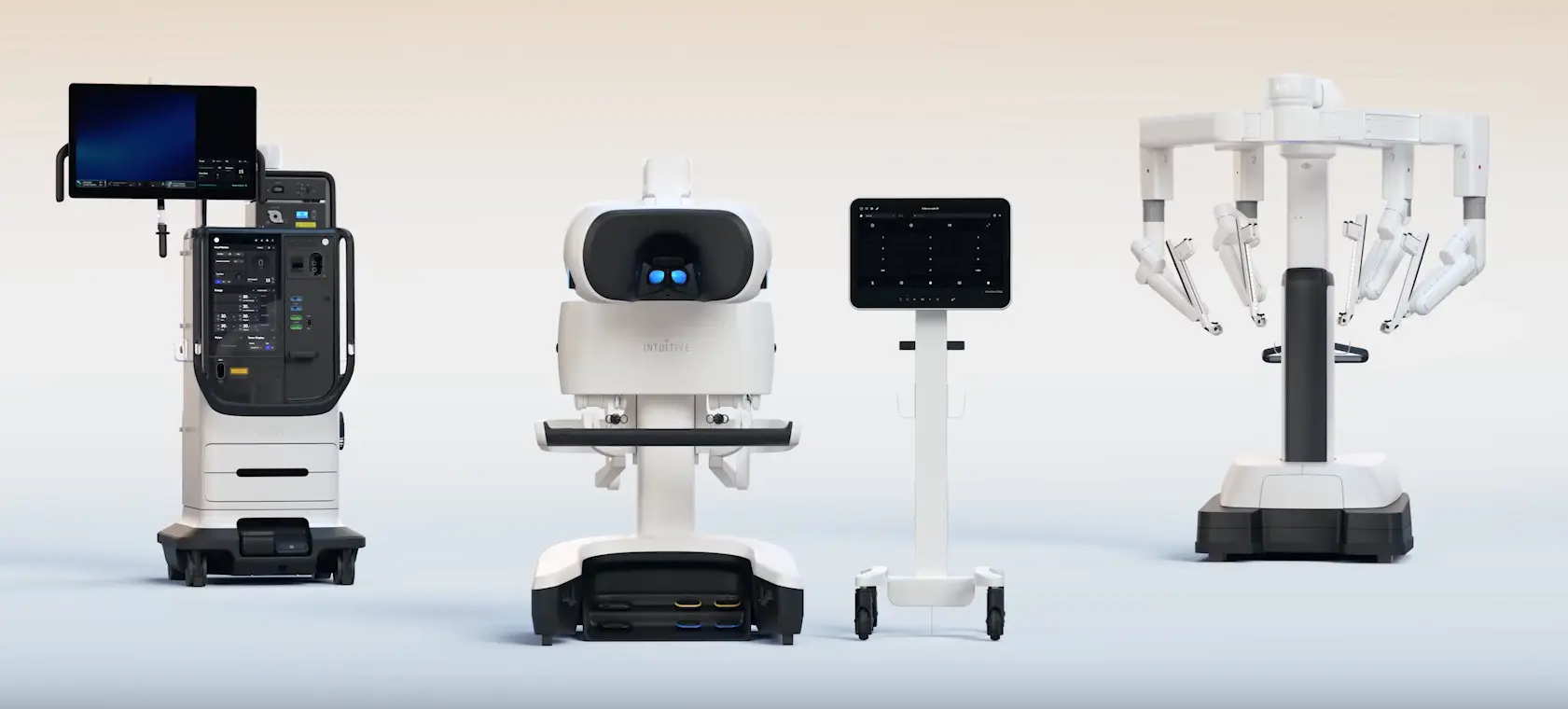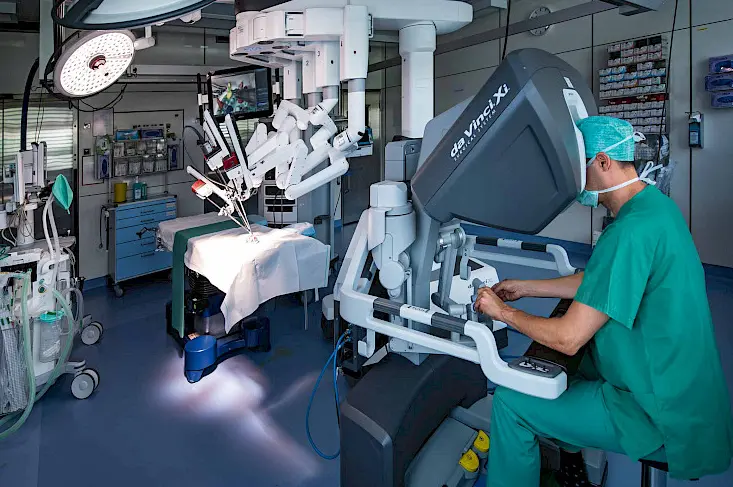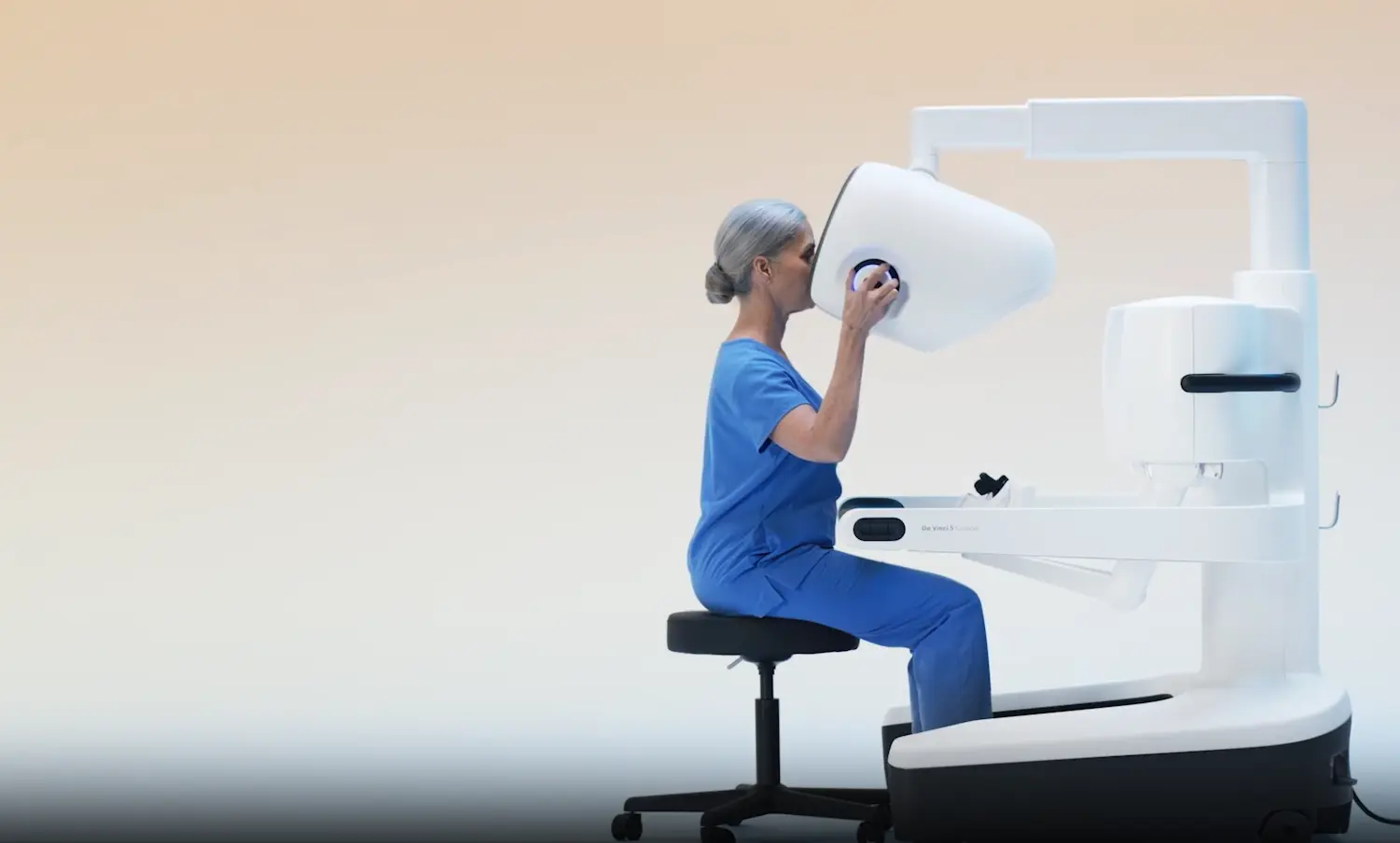
Da Vinci 5 robot surgical system, the most advanced and integrated multiport platform
Da Vinci Robot is a sophisticated surgical tool designed to assist surgeons in performing complex procedures with greater precision. This robotic system is primarily used to enable minimally invasive surgeries, enhancing surgical capabilities beyond the limitations of the human hand.
Implementing such advanced technology could ease concerns and offer a safer alternative for those unsure about undergoing traditional surgery.
Patients often worry about the long recovery times and significant scarring associated with traditional open surgeries. The da Vinci Robot significantly reduces these issues as it supports minimally invasive techniques.
The system enhances the surgeon’s abilities with robotic arms that offer greater accuracy and control, promising quicker recovery and less visible scarring for patients.
Understanding how this system works can empower individuals to make informed decisions regarding their surgical options. Through its innovative design, the da Vinci Robotic Surgical System has transformed how surgeries are performed, providing a more efficient and patient-friendly experience.
Introduction to the da Vinci Robot
The da Vinci Robot revolutionizes surgical procedures with advanced technology, enabling more precise and minimally invasive operations. This section delves into what makes this robotic system unique and explores its history and applications.
What is the da Vinci Robot?
The da Vinci Robot is a surgical system designed to enhance a surgeon’s capabilities while performing minimally invasive procedures. Operated through a console, it translates the surgeon’s movements into more minor, precise actions inside the patient’s body.
It consists of robotic arms equipped with surgical instruments and a camera, providing a high-definition, 3D view of the surgical area. This technology offers significant benefits over traditional surgery, including smaller incisions, reduced pain, and quicker recovery times.
Overview of Robotic Surgery
Robotic surgery involves using advanced robotic systems, like the da Vinci surgical system, to assist surgeons. These systems provide greater control and precision, making them ideal for complex procedures.
Surgeons manipulate the robot’s arms using a console, allowing for highly accurate movements. This approach leads to less blood loss and minimal scarring compared to open surgery.
Da Vinci robotic surgery is commonly used in urology, gynecology, and cardiothoracic surgeries, promoting shorter hospital stays and faster return to normal activities.
History of the da Vinci Surgical System
The da Vinci Surgical System, introduced by Intuitive Surgical, was cleared by the FDA in 2000. It has since transformed the landscape of minimally invasive surgery.
Initially developed with inspiration from projects funded by NASA and the military for remote surgery, it marked a significant breakthrough in medical technology.
Over the years, the system has evolved, incorporating improved imaging, ergonomics, and surgical instruments. Its history demonstrates substantial growth and innovation, increasingly making robotic-assisted surgery a standard across healthcare facilities globally.
Features of the da Vinci Surgical System

A surgeon performs surgery using the da Vinci Robot surgical system in the operating room
The da Vinci Surgical System is a robotic technology that enhances minimally invasive surgery through precision and control. It enables surgeons to perform complex procedures through smaller incisions, resulting in fewer complications and faster recovery times.
Components of the da Vinci Robot
The da Vinci surgical system comprises several key components designed to work together seamlessly. These include a patient-side cart with robotic arms that hold surgical instruments, an advanced vision system offering magnified 3D high-definition views, and a surgeon console where the surgeon operates the robot.
The robotic arms’ range of motion is wider than the human hand’s, allowing for precise manipulation of surgical tools. This intricate system ensures enhanced control and accuracy during surgical procedures.
How Does the system Work?
In real-time, the system translates the surgeon’s hand movements from the console to the robotic instruments. This is accomplished through advanced sensors and cameras that provide a detailed view of the surgical area.
With instruments that can bend and rotate more flexibly, the da Vinci robotic surgery can perform complicated tasks with traditional methods. The surgeon always maintains control, ensuring safety and precision without direct contact.
The da Vinci Console and Its Functionality
The surgeon console is the command center where critical decisions are made. It features an ergonomic design with supportive hand and foot controls for seamless operation.
Surgeons view the surgical field through a 3D high-definition monitor, which provides a clear and magnified view of the surgical area. The console allows surgeons to control the robotic arms intuitively, translating their movements into precise surgical actions. This setup enhances dexterity and reduces fatigue during lengthy procedures.
Types of Surgeries Performed with the da Vinci Robotic System
The da Vinci Robot offers precision in various surgical fields, providing enhanced visualization and control for complex procedures. Its robotic arms allow for small incisions, leading to quicker recovery and reduced patient pain.
Standard Procedures Using the da Vinci Robot
Da Vinci Robotic Surgery is widely used in prostatectomies and hysterectomies. In prostate cancer, surgeons perform precise removals of prostate tissue, which helps preserve surrounding nerves.
Similarly, for gynecological surgeries, such as hysterectomies, the technology allows for greater precision and less damage to nearby organs. The da Vinci Surgical System is also effective in colorectal surgeries, where it aids in minimizing risks and promoting faster recovery. These common uses highlight the versatility of the da Vinci technology.
Advantages of da Vinci Robotic Surgery
The da Vinci Surgical System provides several benefits. It allows surgeons to operate with enhanced accuracy, mimicking natural hand movements through robotic arms.
This precision leads to less blood loss and reduced pain during recovery. The surgeon’s console offers a 3D high-definition view, improving visibility of the surgical area.
Furthermore, minimal scarring is possible due to smaller incisions, a significant advantage over traditional open surgeries. These features make robotic surgery appealing to many patients seeking advanced medical solutions.
What Type of Surgery Does the da Vinci Robot Do?
The da Vinci Robot is used for various procedures across different specialties. It is employed in urological surgeries, including kidney and bladder operations. Gynecological applications range from fibroid removal to endometriosis treatment.
In addition, it assists in head and neck surgeries, offering surgeons control and precision even in confined spaces. As hospitals seek innovative solutions, the da Vinci Robotic System stands out for effectively tackling intricate surgical challenges.
Costs and Training for the da Vinci Robot
The da Vinci Robot offers a mix of innovation and precision in surgical procedures. Integrating this technology into a hospital setting requires significant investment in costs and training.
Da Vinci Robot Cost and Pricing
The acquisition costs of the da Vinci Surgical System range from $0.5 to $2.5 million, depending on the model and configuration. The da Vinci Xi model can sell for around $1.75 million. Hospitals must also consider ongoing maintenance, which can add up significantly.
These expenditures reflect these robots’ cutting-edge technology and capabilities in enhancing surgical precision and reducing patient recovery times.
Intuitive recognizes concerns about patient care costs and is creating cost-effective financing models. Two out of three customers use flexible financing to acquire our technology.
Da Vinci Robot Training Programs
Surgeon training for the da Vinci Robot is crucial to its successful implementation. Initial training costs, covering the first four surgeons, are included in the robot’s purchase price. Da Vinci Learning provides comprehensive training tools.
These programs enhance surgeons’ skills, ensuring they can operate the system effectively and safely. Regular updates and learning modules are available to keep up with advancements in robotic surgical procedures.
Da Vinci Robot Certification for Surgeons
Surgeons must obtain certification to perform da Vinci robotic surgeries. Certification programs involve rigorous coursework, practical skills assessments, and ongoing evaluations to ensure competency.
This certification shows a surgeon’s ability to handle the complex operations involving the da Vinci Surgical System, enhancing their reputation and patient trust. Achieving this certification is critical for those looking to specialize in robotic surgery and utilize the full potential of the da Vinci Robotic Surgical System.
Pros and Cons of Using the da Vinci Robot

The da Vinci Robot5 console provides a 3D high-definition view
The da Vinci Robot offers both promising benefits and notable risks. It enhances surgical precision and reduces recovery times, yet some potential complications still exist. Safety considerations are crucial for patients and medical professionals.
Benefits of Robotic Surgery with the da Vinci System
The da Vinci surgical system offers a less invasive option than traditional open surgeries.
Using robotic arms, surgeons achieve a higher level of precision, allowing for smaller incisions. This leads to less blood loss and quicker recovery times, making it particularly effective for complex procedures.
The Cleveland Clinic highlights that its instruments have a wider range of motion than the human hand, enhancing surgical accuracy and flexibility. Patients often experience less pain post-surgery and reduced hospital stays, resulting in a smoother recovery process.
Potential Risks and Complications
Despite its advantages, the da Vinci Robot is not without risks. Technical failures, though rare, can occur and may complicate procedures.
Surgeons must undergo extensive training to use the system effectively, and user errors can contribute to complications. Some surgeries using the da Vinci system can be expensive due to the cost of the da Vinci robot.
According to All About Women, the reduced tactile feedback compared to traditional methods can also pose challenges, potentially affecting the outcome when dealing with delicate tissues.
Da Vinci Robotic Surgery Deaths and Safety Considerations
While the da Vinci Robot is considered safe, some incidents have raised concerns about its use. Surgical complications have included injuries related to burns and cuts from instrument arms.
It’s important to note that deaths directly linked to the system are extremely rare. Safety procedures are continually updated, and hospitals prioritize surgeon training to minimize risks.
Regulatory bodies and institutions continue monitoring and evaluating the technology to ensure its safe application in surgery.
Closing Remarks
The da Vinci Robot is changing how surgeries are done. By allowing for minimally invasive techniques, this robotic system helps reduce patients’ recovery times. Such advancements mean surgeries are less taxing on the human body.
Due to the system’s advanced capabilities, doctors can conduct delicate procedures with greater precision. The robot assists with tasks like moving instruments in small, precise actions. For more detailed information, robotic-assisted surgery has become an integral part of modern medicine.
The da Vinci Robot is not just about efficiency; it’s about enhancing patient care. Surgical teams can achieve better outcomes by using this technology. Hospitals investing in the da Vinci system are positioning themselves at the cutting edge of surgical innovation.
Key Takeaways: Introducing the da Vinci Robot marks a significant shift in surgical techniques, focusing on precision and patient care. Future developments hold promise for even more advances in healthcare.
Frequently Asked Questions
The da Vinci Robot is a sophisticated tool for performing minimally invasive surgeries in healthcare. It offers precision, flexibility, and control that enhance surgical capabilities.
How much does a da Vinci robot cost?
The cost of a da Vinci robot can range between $1 million and $2.5 million. Maintenance and training add to the expenses. Hospitals consider these factors when investing in this technology.
Is the da Vinci robot still used?
Yes, the da Vinci robot is widely used in modern medicine. It performs complex surgeries with minimal incisions, leading to quicker recovery times and reduced hospital stays.
Who invented the da Vinci robot?
Intuitive Surgical, established in the late 1990s, developed the da Vinci robotic system. Their innovation was inspired by early robotic systems aimed at enhancing surgical precision.
How many da Vinci robots are there in the world?
As of recent counts, over 6,000 da Vinci robots are in use worldwide. These systems enable advanced surgical procedures in hospitals across many countries.
Is Da Vinci robotic-assisted surgery worth it?
Da Vinci robotic-assisted surgery is often considered worth it because of its benefits. Patients experience less pain and scarring and faster recovery. However, the high cost may influence the decision-making process.
How much does it cost to remove the prostate gland?
The cost for robotic prostate surgery using the da Vinci system can vary but is generally between $10,000 and $20,000. This range depends on the healthcare facility and location.
How safe is the Da Vinci robot?
The da Vinci robot is considered safe for surgical procedures. While no surgery is without risk, the system’s precision helps reduce complications. Surgeons continuously train to ensure safety and effectiveness.
What is the most expensive robot?
The da Vinci Surgical System is among the most expensive medical robots. Due to its advanced capabilities and technology, its units and associated costs are substantial.
What surgery is the Da Vinci robot used for?
The da Vinci robot is used for various surgeries, including prostatectomies, hysterectomies, heart valve repair, and bariatric procedures. Its versatility makes it suitable for many complex operations.
Is robotic prostate surgery better?
Robotic prostate surgery is often favored due to its precision, which can lead to less pain, quicker recovery, and fewer complications compared to traditional surgery. Outcomes may vary based on individual cases.
What are the key features of the Leonardo da Vinci Robotic Knight?
Leonardo himself designed the Leonardo da Vinci Robotic Knight. It was an early concept that featured movable joints.
While not a medical device, it demonstrated the principles of mechanical automation.
 I’m Leonardo Bianchi, the mind behind Leonardo da Vinci's Inventions. Thanks for visiting.
I’m Leonardo Bianchi, the mind behind Leonardo da Vinci's Inventions. Thanks for visiting. 


